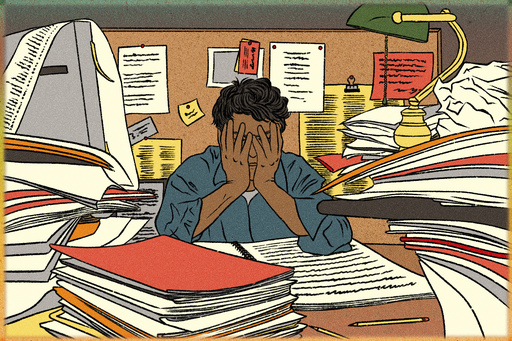NEW YORK — A simple Post-it note, a treat like a chocolate bar for later, and a few charging cords might seem innocuous individually. However, combined with a laptop, a folder filled with projects, a lanyard from a recent conference, and school permission slips, they quickly compound into a daunting pile on your desk.
This growing clutter epitomizes the challenges of modern life, where the convenience of acquiring low-cost items through online shopping compounds our propensity to accumulate unnecessary items. Such clutter, common in both home and traditional offices, can sap our mental and cognitive resources, detracting focus from work and harming productivity.
“Clutter diminishes our mental capacity and skews how we see our surroundings and ourselves,” said Marietta Van Den Berg, a psychiatrist and medical director at Surrey Memorial Hospital in British Columbia. “It impacts our decision-making abilities, stress levels, and even sleep patterns.”
Research at UCLA indicates that women in homes packed with numerous objects experience elevated levels of the stress hormone cortisol. As spring unfolds, households and workplaces everywhere attempt to counteract clutter, aiming for a cleaner environment and improved mental tranquility.
“Things infiltrate our lives too easily. We need a strategy to facilitate their exit,” noted Matt Baier, owner of Matt Baier Organizing in Stamford, Connecticut. “With the ease of Amazon shopping, items arrive in massive quantities, leading to homes cluttered with boxes, both opened and unopened, awaiting returns or disposal.”
Reasons for accumulating clutter vary, ranging from uncertainty about where items belong to procrastination on tasks. Papers might represent chores like bill payments or phone calls, which aren’t immediately tackled. “Clutter is merely a deferred decision or action,” Van Den Berg stated. Organizing papers into categories like “Action Items” saves future time.
“If everything’s disorganized, it hampers one’s ability to perform optimally at work,” noted Renee Brown, owner of Renee Brown Organizing in Minneapolis.
Tackling a cluttered workspace can seem daunting, but Brown advises against attempting it all at once. Instead, she recommends regular short decluttering sessions. “Allocate 15 or 30 minutes in your schedule, or even an hour if time permits, and set a timer,” she recommended.
Corporations now occasionally allocate time for organizational tasks, helping employees manage files and email clutter. Employees sometimes use platforms like Zoom to declutter collectively.
Sorting items into categories helps streamline the organization process. Gathering similar items together can reveal redundancy—numerous identical office supplies, for example. Albertini remarked, “Seeing everything together clarifies the volume and excess of items.”
Baier suggests using a clean area, such as a folding table, for sorting. Organization bins labeled with sticky notes (trash, recycling, keepsakes) aid in the process. “Label one bin ‘elsewhere’ for displaced items, and sort them later to avoid sidetracking,” Baier advised.
Facing endless paperwork is challenging; Albertini suggests checking if retaining certain documents is mandatory. “Assess the last time the document was used or if it’s crucial for future tasks,” she said.
Baier further suggests categorizing papers into ‘running,’ ‘sitting,’ ‘sleeping,’ and ‘dead’ files. “Comprehend the reason for keeping documents; this clarity dictates where they belong,” he explained. Implementing and repeating a paper decluttering system yearly should only require about 20 minutes.
For digital files, employ a strategy similar to paperwork: categorize and eliminate duplicates. “We aim to reduce trivial duplicates,” Albertini said. With photos or presentations, retain only a few key pieces and delete the rest. Evaluate the necessity of keeping emails based on their future utility.
In email management, messages from specific clients or teams can auto-direct into folders. At the year’s end, transfer myriad unread emails into a digital archive, suggested Brown.
Preemptively minimizing clutter involves reducing unnecessary purchases. While acquiring storage solutions is tempting, repurposing existing items like cardboard boxes is a practical alternative. “No need for luxurious buys,” Brown emphasized. “Repurpose what you have available.”


